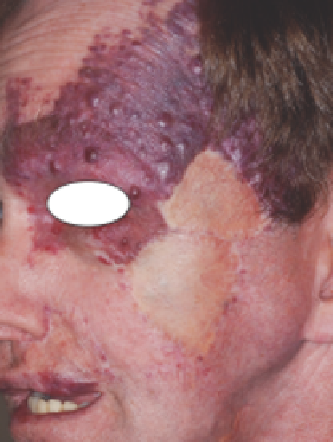Biomedical Engineering Reference
In-Depth Information
(
A
)
(
B
)
Figure 2.20
(
A
) PWS before and (
B
) after 10 treatments with pulsed dye laser; alexandrite laser was also used for nodules on four occasions. Note skin graft that
was placed to treat part of PWS while patient was youth.
Abbreviation
: PWS, port-wine stain.
methods have limited and/or unpredictable results as well as
potentially serious complications.
PWSs, with their specifi cally targeted biologic structure,
serve as ideal candidates for SPT with laser. Utilizing the care-
ful selection of wavelength, fl uence, and pulse duration coagu-
lation can be induced while sparing surrounding tissue. While
the CO
2
laser (88), Nd:YAG laser, copper vapor laser (89,90),
and argon laser (89) have all previously been used to treat PWS
in children, cosmetic results with these lasers have been poor
in children, with the risk of scarring unacceptably high. Con-
sequently, the PDL remains the gold standard of treatment for
most PWS, although newer-generation IPLs and KTP lasers
have evolved as reasonable options.
Prior to laser surgery, everyone in the treatment room should
wear wavelength-appropriate safety goggles. Adults may use
standard eye goggles for protection, but these may not fi t prop-
erly on infants and young children. In such instances, white
gauze may be used to cover the periorbital area (63). If the
PWS is itself located around or near the eye, patients should
also utilize opaque laser eye shields placed prior to treatment;
this can be done immediately after the child is anesthetized if
general anesthesia is used.
Anesthesia is an important concern when performing laser
surgery in the pediatric population. Topical anesthetics that
are commonly utilized include lidocaine 4% gel and eutectic
mixture of local anesthetics (EMLA), which is 2.5% lidocaine
and 2.5% prilocaine. EMLA has been known to cause local
vasoconstriction that may impede visualization of the lesion
itself and decrease effectiveness of treatment with laser (91).
Additionally, its constituent, prilocaine, has a known risk of
causing methemoglobinemia in children less than six months
old as a result of immaturity of erythrocyte methemoglobin
reductase, the enzyme that converts met-HgB to HgB. Chil-
dren with glucose-6-phosphate dehydrogenase defi ciency and
other hemoglobinopathies may also be at particular risk.
Consequently, alternatives to prilocaine anesthetics should be
considered when possible (92). While older children may
tolerate the laser procedure using topical anesthetics only,
infants and young children may require general anesthesia.
General anesthesia affords the laser surgeon the ability to cover
larger areas and to avoid the risk of unexpected movements
during treatment of delicate anatomic areas requiring techni-
cal fi nesse. While the risk of general anesthesia on the develop-
ing infant's brain remains a controversial subject, most
pediatric laser surgeons advocate for its use in younger chil-
dren with larger lesions (93).
Cooling the skin is crucial to minimizing damage to sur-
rounding tissues and for reducing the risk of postoperative
complications such as swelling, scarring, and postinfl amma-
tory pigmentary changes (especially in darker-skinned
patients). This may be accomplished using an attached cooling
device that provides a targeted cryogenic spray to the super-
fi cial skin a fraction of a second before the laser energy is
delivered (Fig. 2.21). Likewise, cool air machines can blow
continuously cooled air across the treatment site. Cold com-
presses or bags of ice applied immediately to the treated area
are another useful low-tech, low-cost tool that should not be
underestimated.
Recent attention has been given to angiogenesis inhibitors
as a novel means of preventing reformation and reperfusion of
PWSs after photothermolysis. Angiogenesis inhibitors are a
varied class of compounds that include cleaved proteins, mono-
clonal antibodies, and natural products used to prevent the
development of malignancies. Rapamycin, an inhibitor of the
mammalian target of rapamycin, has shown particular promise
through its ability to inhibit proliferation of vascular endothe-
lial cells. It has been well studied in transplant populations and
appears to have a minimal side-effect profi le (94-96). While
long-term studies in humans with PWSs are lacking, vessel
reperfusion has been effectively reduced in hamsters using laser
with daily topical application of rapamycin versus laser alone
(94). It is postulated that this is accomplished through suppres-
sion of vascular endothelial growth factor and hypoxia-sensitive
gene transcriptional regulators, such as hypoxia-inducible factor
1-alpha (97). It remains to be seen whether other agents such
as topical or oral beta-blockers (e.g., timolol or propranolol,
respectively) have a role in decreasing PWS angiogenesis as has
been demonstrated in hemangiomas of infancy (98,99).

















